Upgrade Canned Chili With These 21 Simple Ingredients
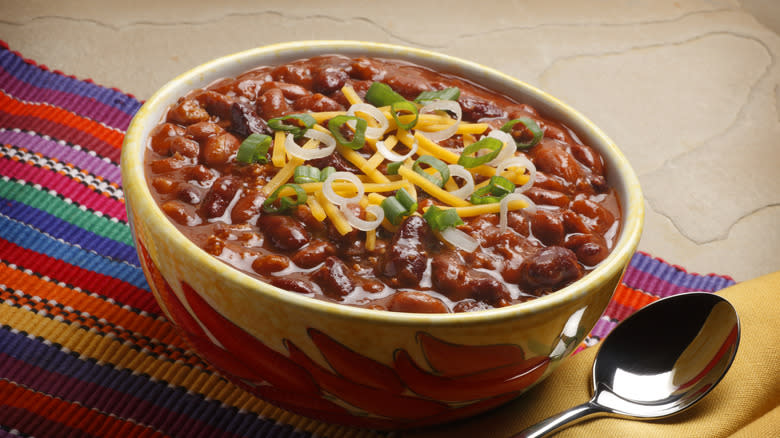
Canned foods are indispensable staples to keep on hand for a quick and easy meal. Chili is an ideal canned food because it has a high protein content and is filling. It also comes in myriad varieties to appeal to virtually every palate. Whether you like your chili with or without beans, even the finest canned variety can leave you wanting a bit more texture, aroma, and flavor.
There are numerous ways to take canned chili from tasting like store-bought to something more sophisticated. You can make it your own and more elegant by adding complexity. This means going beyond just adding toppings. It means Incorporating elements to tickle all your taste buds, including sweet, sour, salty, bitter, and umami. And don't forget to plate it up nicely. Presentation is just as important when upgrading something from basic to brilliant.
As a chef, I've flexed my creative juices to test several ingredients to take canned chilis to the next level. Because of my background in cultural anthropology, I knew there were more ways out there, so I took some inspiration from variations on chili and bean dishes across the U.S. and globally. Read on to see how you can upgrade canned chili with simple ingredients.
Read more: 11 Of The Best Cooking Tips From Bobby Flay
Cocoa Powder
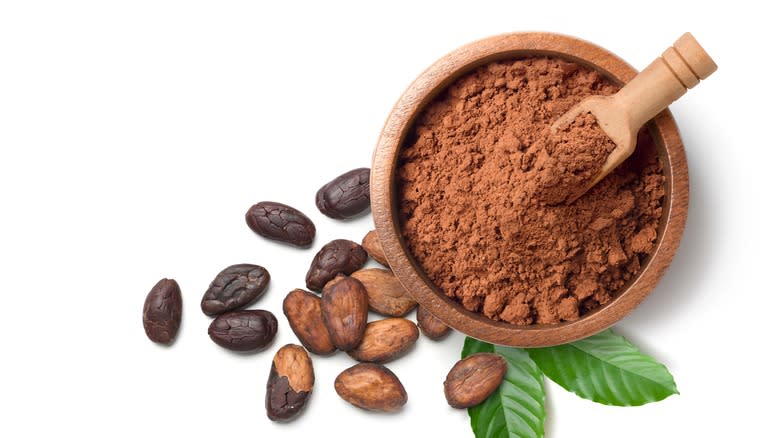
One of the most sophisticated ways of upgrading your can of chili is to incorporate some cocoa powder. This ingredient takes inspiration from sauces like a slow-simmered Mexican mole poblano or recipes for Cincinnati chili. Both of these recipes rely on the use of chocolate for complexity and richness in flavor.
While you could incorporate dark chocolate chips, adding cocoa powder is easier and quicker. Cocoa powder will dissolve almost instantly into your hot chili and tends to be more bitter than sweet, which is more suitable for amping up the flavor. The key is to use a good quality cocoa powder that is unsweetened, has no stabilizers or anti-caking agents, and is made from 100% pure cocoa.
Canned Cinnamon Rolls

The next upgrade comes from a Midwestern classic combining cinnamon rolls with chili. In the 1960s, school cafeterias across the Midwest served cinnamon rolls with chili. This tradition likely emerged with the establishment of the USDA's National School Lunch Program in 1946. While its popularity has waned with updated nutritional guidelines, the combination is sound. It pairs sweet with savory, highlighting spices like cinnamon, a common addition to recipes like Cincinnati chili.
The next time you pop open a can of chili, bake off some canned cinnamon rolls. Serve them hot out of the oven. The only decision you will have to make is whether to tear the whole thing up into pieces and pop them into your chili, like pillowy croutons, or rip and dunk morsels as you gobble up your meal.
Sausage Links, Bacon, Or Leftover Ham

The combination of franks and beans dates back to the American Civil War when the Van Camp Packing Company began providing meals to soldiers. One of the more popular menus offered was a stew of pork with beans in a tomato-based sauce that closely resembles chili. In the 1980s, canned iterations of this combination became all the rage, solidifying its legacy as an authentic American culinary invention.
To incorporate some of this historical nostalgia into your chili, consider doctoring up your bean-based brand of choice with sausage links, bacon, or leftover ham for a similar salty and umami-rich pop of flavor. Slices of grilled or pan-seared spicy and smoky Polish kielbasa are particularly delicious in chili, and the texture is somewhat reminiscent of a sophisticated hot dog.
Hot Sauce

The idea of adding something spicy to chili isn't exactly novel. Most recipes for the dish involve the use of peppers and chili powder. This is likely a throwback to classic chili con carne dishes popularized by taco trucks in Texas in the late 1800s. These early chili dishes were known to be quite hot.
Traditional canned chili recipes can be lacking in the heat department for those who like spicy foods. The spice is generally tamed to accommodate a wider swath of the population. The solution is to add some hot sauce to your canned chili. Sriracha, gochujang, harissa paste, or sambal oelek will all do the trick. Each of these occupies slightly different lanes in heat levels, umami flavors, and the funkiness of fermentation that can completely transform your chili into something exotic.
Lemon Juice

The addition of lemon juice to chili is inspired by classic bean dishes prepared throughout North Africa and the Middle East, particularly in Egypt. Historically, ful, or beans, were slow-cooked underground over hot coals. Most recipes for ful incorporate some acidity from lemon juice to balance out the richness of the beans and pull all the flavors together.
The bright tanginess cannot be underestimated in its transformative nature. Once you try it, you won't be able to eat chili without it again. While freshly squeezed is best, you may not want to cut into a lemon for just a squirt of juice. It is easy to obtain jarred fresh lemon juice to keep on hand for cooking, which is convenient and just as flavorful. Apple cider vinegar will work in a pinch but tends to be more aggressively acidic than lemon juice.
Hummus

Stirring some hummus into your canned chili probably sounds redundant. Why would you add beans to beans? It isn't as far-fetched as you may think. Across countries in the Middle East, there is a dish known as Hummus bil Lahme or hummus with ground meat. This recipe involves cooking ground beef with rich spices, including cumin, paprika, allspice, cinnamon, cardamom, cloves, and pepper. The spicy meat is dished out atop freshly made hummus and served with pita.
This combination of creamy hummus with sweet and savory meat is satisfying and delectable. It also reminds us of Cincinnati chili. The next time you want to put a Middle Eastern twist on your chili, try stirring in some store-bought hummus. You can get even more creative with it by using one of the seemingly endless different varieties of hummus available, like roasted pepper or garlic.
Ground Meat
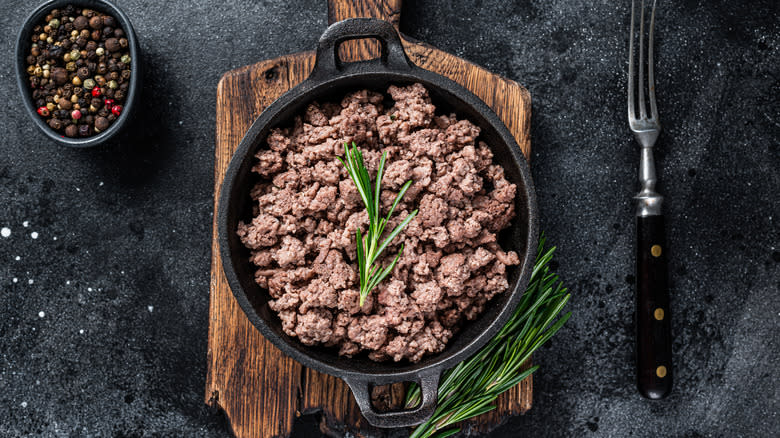
You can always add your ground meat if you purchase a vegetarian chili. The advantage to doing this is both cost and the option to use something other than beef in your chili. I enjoy ground lamb meat and game, like buffalo or venison. Alternatively, ground turkey or chicken is a good choice for those watching their saturated fat intake.
Just be sure to spice up your ground meat before you brown it with chili powder, smoked paprika, cumin, cinnamon, salt, and pepper. You also could add some garlic and onion powder for some aromatics, but this may not be necessary if your canned chili is already highly seasoned. And don't forget to drain any excess fat from your ground meat before adding it to your canned chili.
Canned Fish
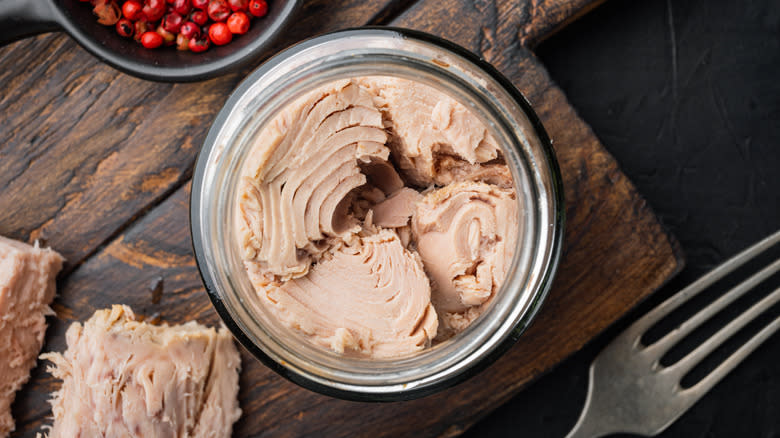
Incorporating tuna, salmon, or anchovies into your store-bought chili comes from a southern Chinese specialty of fried dace with fermented black beans. This combination, sold in cans and generally eaten over white rice, is a delicacy that became popular in the late 1800s as a convenience food for Chinese workers abroad.
The fermented black beans paired with this freshwater fish pack an umami bomb that can be recreated by augmenting your canned chili with readily available canned or vacuum-packed fish. While I prefer smoked salmon for this purpose, for a saltier bite, place an anchovy into your saucepan with a hint of olive oil and cook it until it disintegrates into a paste. Add your canned chili to infuse it with a distinctive flavor that can't be beaten.
Pumpkin Pie Spice

While the addition of pumpkin pie spice to virtually everything edible and non-edible is a common fad around the holidays, its incorporation into canned chili has less to do with recreating the festive flavors of Christmas and more to do with the origins of Cincinnati chili. Macedonian immigrants are credited with the invention of this legendary dish in 1922. It first appeared on the menu of their Greek restaurant, the Empress.
What set this spaghetti chili apart was the addition of a Middle Eastern spice profile, including cinnamon and allspice. The primary ingredients in pumpkin pie spice are cinnamon, ginger, nutmeg, allspice, and cloves. Their characteristic warmth will enhance the spiciness of any canned chili with or without beans, giving it an exotic flair.
Maple Syrup

One of the quintessential foods of Quebec is a hearty bean dish known as fèves au lard. This dish hearkens back to the indigenous populations of the region. A combination of beans, animal fat, and maple syrup was slow-cooked in earthenware vessels over hot coals until rich and luscious. The recipe was subsequently adopted by French settlers, becoming Canada's de facto national dish.
The key is the maple syrup, which lends a richness equally effective at elevating your canned chili. The sweet maple will temper the spiciness, providing a delightful balance of flavor. Just use pure maple syrup, not a table syrup, made from corn and artificial flavors. These lack the nuance of the real deal. For the most robust flavor, select a dark-colored Grade A syrup. These have earthy, bitter notes that are very complex.
Rice
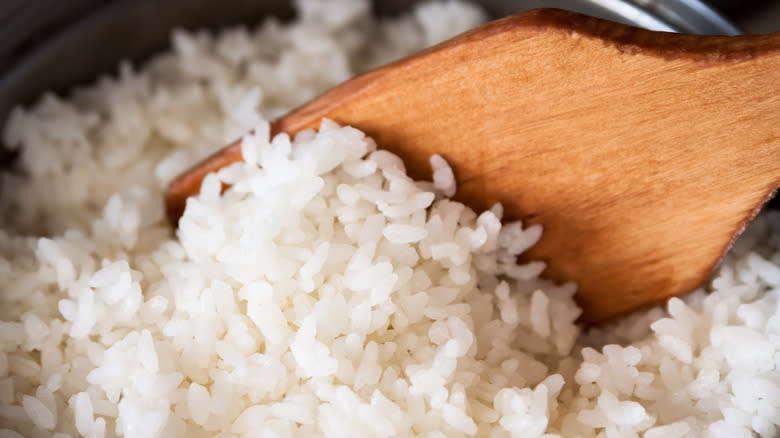
The combination of beans and rice is found in many cultures. Red beans and rice are a classic Louisiana tradition that grew out of the necessity of women to produce a hearty meal without a lot of active cooking while doing the laundry every Monday. These resourceful ladies took beans, leftover meat bones, vegetables, and spices and slow-cooked them all day. This chili-like dish was then served over a bed of rice.
To add rice to chili, instant rice is the best option. Do not add the rice directly to your canned chili. It will absorb all the liquid. You should pre-cook the rice and stir it into your canned chili for a play on this Louisiana comfort food. Choose a flavored rice, like Spanish or Jambalaya, to infuse more bold seasonings.
Peanut Butter
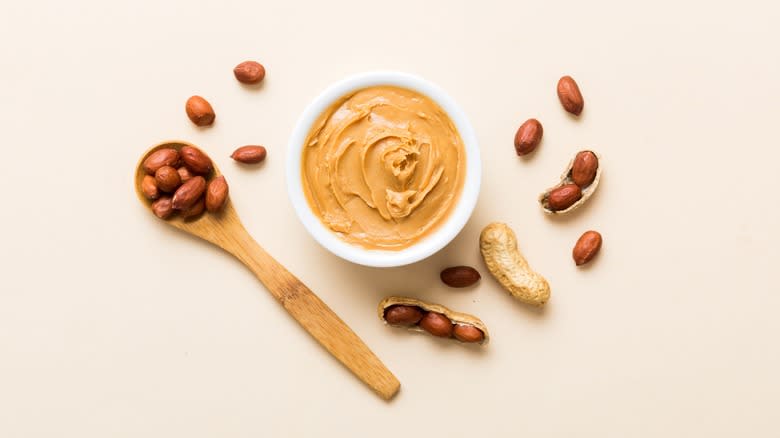
Peanut butter-based stews are popular in several West African nations. One such stew is called Maafe. It originated in Mali and takes advantage of combining meat with aromatics, vegetables, tomatoes, and spices with peanut butter for a rich, velvety soup-like stew that is typically served over rice. Its heat and texture are reminiscent of chili, which makes adding peanut butter to canned chili a natural fit.
Speaking of natural, make sure you use all-natural peanut butter. You can opt for chunky or creamy, depending upon which you prefer. If you notice your peanut butter has separated, stir those oils together with the peanut butter before adding a spoonful to your chili. The result is nutty, rich, and luxurious.
Greek Yogurt

The term dal encompasses a specific type of Indian dish and its star ingredients, beans or pulses. These stews are often made from lentils, peas, or other beans combined with various spices, chilis, and aromatics. While recipes vary by region, these dishes are commonly garnished with yogurt to help cool the spiciness of the chilis added.
This brings us to using Greek yogurt in canned chili. The similarities in heat and spices between canned chili and dal dishes make yogurt a natural addition. Greek yogurt is rich and thick, having more of a texture similar to sour cream. Try using a higher-fat Greek yogurt rather than a low-fat one. It will provide a more pleasurable mouthfeel and be incorporated into the chili more easily without clumping.
Cheese
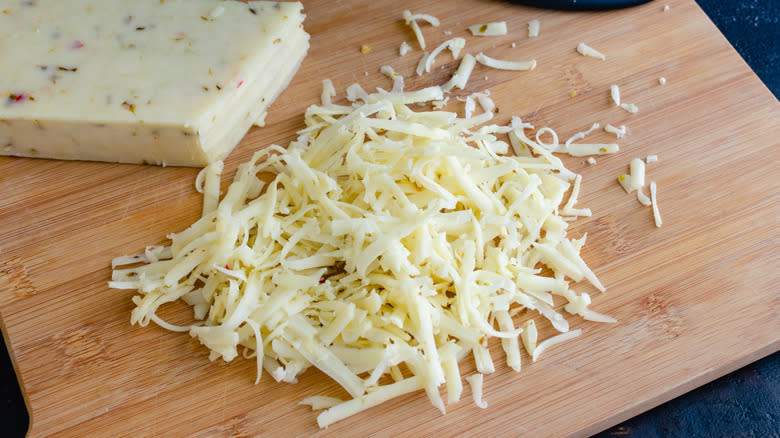
Early iterations of chile con carne were often served atop cheesy enchiladas, so adding some on top of chili is a natural fit. The key is to use a cheese that will melt well when you stir it into your hot canned chili. A good rule of thumb is to consider what cheeses work well in a grilled cheese sandwich. Many of these will work equally well stirred into your chili.
Favorites for this purpose include Monterey and pepper jack, cheddar, and Colby cheeses. You can also use something more delicate, like a queso fresco. Lastly, though it doesn't melt per se, feta does tend to soften and develop a creamy texture when heated. It also has a lovely saltiness that cuts through spices, which makes it an ideal accompaniment to canned chili.
Jarred Pesto
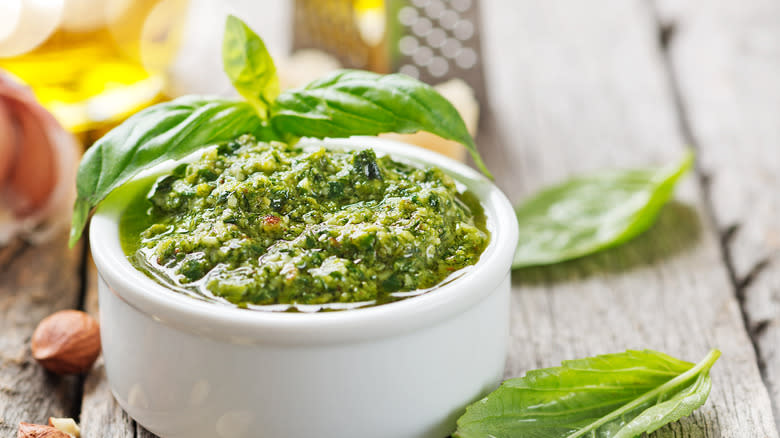
The similarity between a meat-based chili and a classic Bolognese is not lost on me. Both contain ground meat combined with herbs, spices, and tomatoes and are simmered to luscious perfection. Beyond the spices used, the primary difference is that Bolognese is finished with milk for a creamier, less tomato-forward end product. A classic Bolognese usually gets garnished with freshly grated parmesan cheese and julienned basil. These are the main ingredients in jarred pesto, with garlic, olive oil, lemon juice, and pine nuts.
The bright, earthy combination is a marvelous pop of flavor for a hearty meat chili. The acidity of the lemon juice will cut through the heat. The basil leaves will provide some freshness. The astringent pine nuts will confer a hint of bitterness. The cheese lends a punch of nuttiness. The olive oil has a fruity finish. It is a match made in chili heaven.
Kimchi
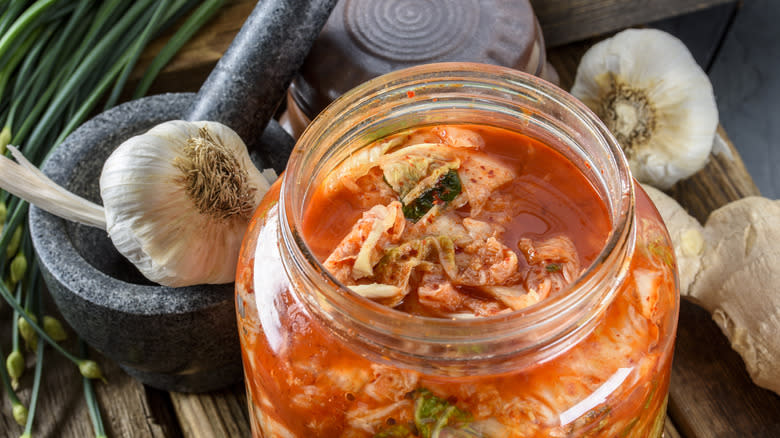
Kimchi is an authentic Korean condiment of pickled and fermented raw vegetables, like cabbage and radishes. Though recipes vary from household to household, flavorings often include salt, garlic, ginger, green onions, fish sauce, and a chili powder known as gochugaru. The result is a funky, probiotic-rich slaw used in practically everything to add umami, acidity, heat, and crunch.
Its distinctive flavor makes it ideal to add to canned chili. Not only will it amp up the spiciness, its acidity will help cut through the rich meat and beans, adding a layer of textural interest that can otherwise be lacking. For a hint of added complexity, a drizzle of sesame oil on top of your kimchi will send your chili into the stratosphere.
Chopped Pickles
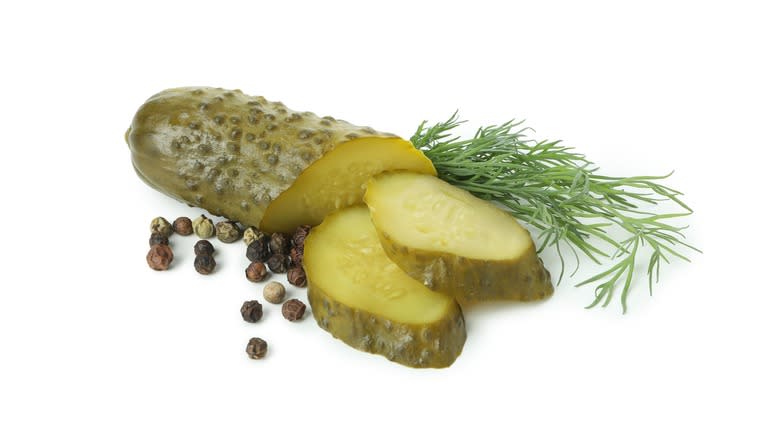
One need not look further to be inspired to add pickles or relish to canned chili than a chili dog. Pickles add acidity to cut the spiciness of the chili, incorporate umami flavors, and add a crunchy texture that provides a playful mouthfeel.
Don't stop at adding chopped pickles. Pop in some of the pickle juice. Pickle juice is delicious and has become a health fad as of late. According to the Cleveland Clinic, pickle juice is rich in probiotics that may aid digestion and increase metabolism. It also contains electrolytes for a post-exercise boost, may help regulate blood sugar, and even help you recover from a night on the town of too much drinking. The next time you are hungover, try having a hot bowl of canned chili doctored up with pickles and their juice to help you rebound faster.
Coffee

You may have heard of adding coffee to chocolate desserts to help amplify their flavor, but did you know that doing so with chili can accomplish the same result? The aroma of coffee accentuates the spices added to chili, and its inherent earthiness and slightly bitter aftertaste can help to temper heat.
The key is knowing how to add coffee. Finely ground espresso or instant coffee is fine for baking. That said, when adding coffee to canned chili, it is better to add already brewed coffee so you do not have to worry about the grounds completely dissolving. You will want a strong brew and never use flavored coffee. And keep in mind that a little goes a long way. You aren't adding enough for a caffeine buzz. Too much will overwhelm all of the other flavors in your chili.
Alcohol

We have always maintained that picking the right glass of wine or beer can make or break a meal. So does incorporating it into your food, particularly meaty and saucy foods like chili. Doing so can enhance their flavor and aroma. There is science for why this happens. Alcohol adheres to fat and water molecules, acting like a carrier beacon for them. This helps to draw those molecules to your nose and taste buds, producing a more complex culinary experience.
Cooking with alcohol is also a great way of using up leftover alcohol. When considering what kind of booze to add to chili, opt for darker alcohols that can complement strong spices and fatty meats. Dark beers, like a stout, bourbons, or even a hint of red wine, like a pinot noir, can all work. Just be measured with how much you add, and make sure to heat it through completely.
Canned Squash

A foundation of Native American cuisine is something known as the "three sisters." These three crops, corn, squash, and beans, were grown together. The corn was utilized as a kind of trellis upon which squash could grow, and the beans behaved as ground cover, helping to fertilize the soil and keep weeds from sprouting up. On the plate, they often were served together, forming the perfect nutritional profile to keep Native populations healthy.
Adding canned pumpkin or butternut squash to chili comes out of this heritage. Not only does it make nutritional sense, it is delicious. The squash lends a velvety texture to the chili while tempering the spices. It also confers a hint of sweetness to balance out aggressively hot chili recipes.
Corn

Expanding on the "three sisters" theme in Native American culinary tradition, adding canned or frozen sweet corn is a fabulous way to doctor up canned chili. Sweet corn is frozen or canned at the height of its freshness, ensuring peak flavor and nutritional value. Its bright yellow color and slightly chewy texture can provide visual appeal and a more complex mouthfeel.
Just be careful not to use creamed corn. It will water down your chili and contains added sugar and starches. For something different, you can also use Southwest corn, with poblano and red peppers added for a hint of extra smokiness and heat. In a pinch, you may also consider using baby corn. These are commonly seen in Asian cuisine and have a milder and more earthy flavor than sweet corn.
Read the original article on Daily Meal.

